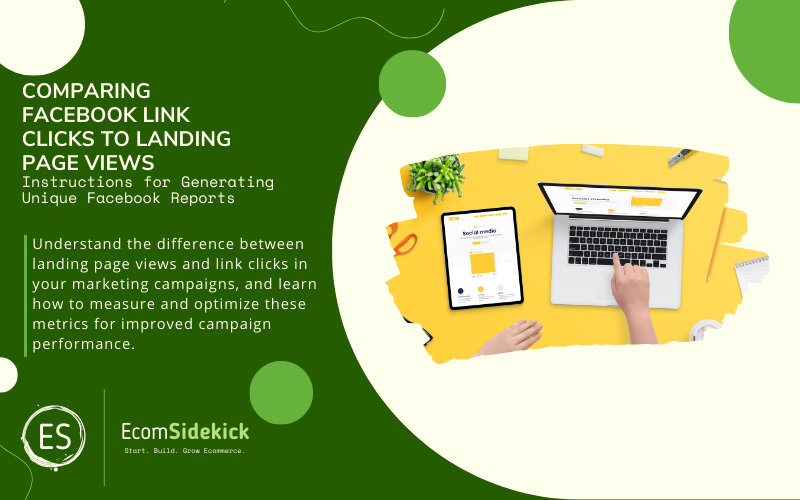Many advertisers ask what the difference is between Facebook Click, Facebook the Pixel Fire feature in ads Manager, and Facebook Insights. Many need help analyzing their website traffic and creating reliable reports. This also needs clarification over whether their campaign’s effectiveness is satisfactory.
Understanding their differences will allow you to optimize your PPC marketing strategy if focusing exclusively on Facebook Marketing.

Related content: Ecommerce for Beginners (Steps to Starting Your Online Business)
To help you understand the difference between landing page views and link clicks and what you need to know, here are some key aspects you should take into consideration:
Difference Between Link Clicks And Page Views On Landing
Facebook A Click Against Facebook Pixel Fire
The Link click is the number of clicks to links in the Facebook advertisement that took the user to a webpage, either on or off Facebook. It is among the Facebook Ads metrics you should examine to determine your ideal client’s interests. This metric can help you improve your campaign goals and click-through rates, and conversions from click-throughs.
In contrast, “landing page views” is the number of times a user successfully opened the page or immediately followed an ad link’s click. Be aware that you need to develop a Facebook tracking pixel and install it on your site to track the standard page view events and your page’s conversion rate. It allows you to observe the larger picture of your website’s performance and the user journey.
Factors Of Discrepancies
The inability of pixel codes to activate on every click results in an ineffective route back to the page, which is the primary reason behind the disparity in the outcomes. These are some reasons why not all clicks will result in visited pages.
- Users, mainly when using smartphones, may visit your ad and immediately press the back button before arriving at your website.
- If your site’s landing page takes a long time to load, visitors will leave your site the majority of the time.
- Click metrics generally measure clicks to the profile of the business page or profile image, then expand your media until it is full screen. You can also post reactions or even share comments. This is why, more than less, the amount of clicks is more than that of site visits.
- The same person who clicks your ad several times within an insignificant amount won’t count in the count of landing page clicks. As Facebook pixels only fire for each new user. It is not per user click.
Make Custom-Built Reports Using Landing Page View
To attract more customers through your Facebook custom audiences, keeping track of website conversions and understanding conversion occasions is essential to reach your advertising goal. To make an individual report on conversions, you’ll need to follow the following:
| 1. Log into Facebook Business Manager and then click on Your Ads Manager account. |
| 2. Click on your Campaigns tab, click “Columns,” and select “Performance.” |
| 3. Select “Breakdown” and select “Placement & Device.” (You can sort it based on the settings you prefer). |
| 4. Go back to “Columns,” click on “Customize Columns,” and search for “landing page views” in the search bar. |
| 5. Review the following: Total, Unique Cost, and Unique Cost. |
| 6. Return to “Columns,” hover over “Custom,” and click the option “Save” next to it. |
After completing the process, you’ll be able to view the main metrics that are part of Facebook ads, like Links Clicks, outbound Visits, and Landing Page Views. From there, you can look at essential data such as conversions based on view and bounce rates, engagement rates, and insights into the audience. Which will assist in creating an analysis of your campaign, improve your traffic goals and increase the amount of targeted traffic toward your site.
Link Clicks Vs. Landing Page Views

Page views provide more details than Link Clicks, which makes them an excellent measure to track the continuous effectiveness of your advertising.
In this article, we’ll not only describe how to utilize the tools for measuring the performance of ads in your favor. But also explore why your FB advertising might not perform and provide some advice to boost the number of leads (the highest numbers) to increase the number of tips that convert and make the money you invest on Facebook advertisements worth it.
What Is The Difference Between The Two Types Of Links? Clicks As Well As Landing Page Views?
Yes. There’s a difference between Link clicks as well as Landing Page Views. Both are a measure of clicks on an advert hyperlink; however, Link clicks only show that the Link was clicked. Landing Page Views determine the number of people visiting your destination URL, allowing the page to load fully.
The essential thing that Landing Page Views tell you is the number of people who saw your ad in its entirety rather than those who have clicked on your Link.
Landing Page Views are more reliable in knowing how your Facebook advertisement is doing. Because it eliminates unintentional clicks and leads that are not committed. This information can be used to build your business and attract new customers. It is also a good indicator of how many people stayed long enough to check out what you can offer on your website’s destination URL page.
If you’re paying for ads that bring traffic to your site, be sure you’re using landing Page Views on Facebook. Because it is the most reliable measurement available to determine the effectiveness of this strategy.
It doesn’t mean Lick Clicks aren’t beneficial. They could be, but ensure that you’re using all the available data and know-how information is gathered to know what results mean for your campaign.
To allow the Landing Page Views feature to function, You’ll need to set up Facebook Pixel at your destination. This could be your site or third-party landing pages.
Are Link Clicks Only Count Clicks That Are Inside Facebook?
No. Link Clicks are the number of clicks your advertisement places on Facebook regardless of the Link leads. When the hyperlink you posted tips to a landing page with your website’s URL and an inside the Facebook video, all clicks are counted equally.
Is There A Distinction Between Unique Clicks As Well As Link Clicks?

Yes. Link Clicks can show the amount of interest your advertisement received. Unique Link Clicks will reveal how many leads you might have.
For instance, If Sally, one of your Facebook users, comes across your advertisement and clicks it three times, The Link Clicks will show three clicks while the Unique Link Clicks will show just one.
Sally is one of the prospects who has clicked three times. What information would you like to make use of?
Link Clicks count the number of clicks received, even when the same person has clicked several times. Unique Link Clicks gives you the number of users who clicked. This number could be different from what number of clicks you got.
Review your Link Clicks, and Unique Link Clicks to find additional information about how your Facebook advertising is performing.
There are three distinct kinds of click metrics available on Facebook. Each is related, but each shows different data. This is a brief overview of the available options.
Every performance metric is essential to consider in your Facebook campaign’s improvement. This will assist in making your Facebook marketing to be more efficient and generating income.
Suppose you can interpret and comprehension of these metrics. In that case, you’ll be able to efficiently distribute your daily budget and marketing efforts to other campaigns or companies, resulting in greater profits.
Make sure you are creative when creating campaign goals, and make sure you are analyzing and studying your report. It’s bound to influence your ads’ relevancy and conversion percentage. Remember us after you’ve reached the top of your company!
Frequently Asked Questions
What are landing page views and link clicks?
Landing page views and link clicks are essential metrics in digital marketing that help measure the effectiveness of a marketing campaign. Landing page views refer to the number of times a particular landing page has been loaded or seen by users. On the other hand, link clicks represent the number of times users have clicked on a specific link that directs them to the landing page. These metrics play a crucial role in analyzing the success of a campaign and understanding user behavior.
What is the difference between landing page views and link clicks?
The main difference between landing page views and link clicks lies in what they measure. Landing page views count the total number of times the landing page has been accessed or loaded, including repeat visits from the same user. Link clicks, on the other hand, count the number of times users have actively clicked on the link that leads to the landing page. In short, landing page views represent page visits, while link clicks represent user engagement with the link that drives traffic to the landing page.
Which metric is more important: landing page views or link clicks?
Both landing page views and link clicks are important, but their significance depends on the specific goals of the marketing campaign. Landing page views provide insights into the overall traffic and popularity of the landing page, while link clicks indicate how successful the call-to-action (CTA) or link in the marketing content is at driving users to the landing page. For campaigns focused on exposure and brand visibility, landing page views are valuable, while link clicks are crucial for campaigns aimed at driving conversions and user actions.
How can I improve landing page views and link clicks?
To improve landing page views, focus on optimizing your landing page’s content, design, and relevance to the marketing campaign. Ensure that the landing page aligns with the message of your ads or promotional materials. To increase link clicks, craft compelling and clear CTAs that encourage users to take action. Utilize engaging visuals and persuasive copy to entice users to click on the link and visit the landing page. A/B testing different elements can also help identify which variations are more effective in driving traffic.
What other metrics should I consider when analyzing landing page performance?
When analyzing landing page performance, several other metrics come into play. Conversion rate, bounce rate, average time on page, and the number of form submissions (if applicable) are crucial indicators of how well the landing page is performing. Conversion rate measures the percentage of visitors who completed the desired action, such as making a purchase or filling out a form, among all the visitors. Bounce rate indicates the percentage of users who leave the landing page without taking any further action. These metrics provide deeper insights into the landing page’s effectiveness in achieving campaign goals.
Paul Martinez is the founder of EcomSidekick.com. He is an expert in the areas of finance, real estate, eCommerce, traffic and conversion.
Join him on EcomSidekick.com to learn how to improve your financial life and excel in these areas. Before starting this media site, Paul built from scratch and managed two multi-million dollar companies. One in the real estate sector and one in the eCommerce sector.

